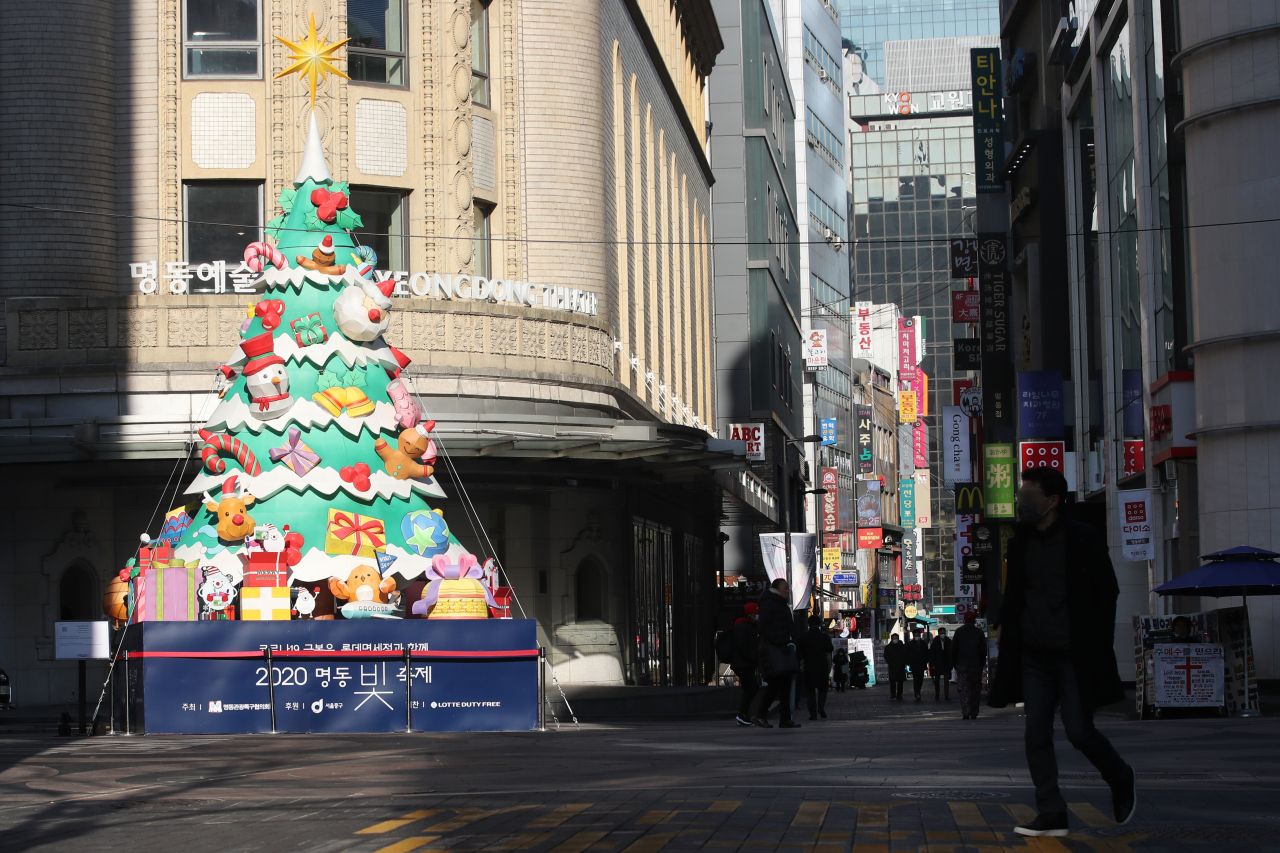Private gatherings of 5 or more banned in Seoul area until Jan. 3
Korea sees another day of record COVID-19 deaths
By Kim ArinPublished : Dec. 21, 2020 - 15:03

Seoul officials said Monday that nonessential gatherings of five or more people would be banned before Christmas and through the New Year’s holiday.
The metropolitan government told a virtual news briefing that “all gatherings of a private nature involving five people or more both indoors and outdoors” would be banned between Wednesday and Jan. 3. An exception is being made for weddings and funerals, where up to 50 people will still be allowed.
Gyeonggi Province, which surrounds the capital, and nearby Incheon followed up later in the day to ban gatherings of five or more people in the same period. Greater Seoul, which encompasses the three districts, has been the main center of COVID-19 spread in South Korea after the initial wave in the spring, with cases there accounting for over 60 percent of all local cases to date.
In a briefing held earlier, the Ministry of Health and Welfare hinted at similar measures intended to discourage social mingling over the holiday season to be announced the next day.
“This does not mean we would be raising the restrictions to Level 3 -- the most intensive tier,” the ministry’s spokesperson Son Young-rae explained.
“The goal is to be able to bring the cases down to an acceptable level without having to move on to the most stringent tier, so that the impact on the economy can be minimized,” Son said, adding, the plans for compensating vulnerable businesses and workers are still to come.
Since a week ago, Korea’s COVID-19 situation has been eligible for the top social distancing tier, which is imposed when between 800 and 1,000 cases occur per day, according to the guidelines updated Nov. 1. Last week, the average of daily cases has averaged 934.4.
The ban on private gatherings comes as hospitals groan under the third surge of COVID-19 and as more patients have died while waiting for treatment.
So far this month, 18 people have lost their lives while waiting for more than 24 hours after being diagnosed with COVID-19, the government said Sunday afternoon. The number of people who died after waiting for shorter periods is unknown. This excludes 30 people who died while being transported to, or shortly after arriving at, emergency services.
There have been patients with COVID-19 dying without having access to medical care during previous peaks in the pandemic.
In late February and early March, five people in then-epicenter of Daegu and North Gyeongsang Province had died waiting for treatment, the government said. Then again in August, a Gyeonggi woman in her 70s was discovered dead at her home after testing positive for the virus.
The government said it was debating whether all of these deaths could be “attributable to the delayed admission to hospitals,” and later corrected that only three of these cases would be categorized as such.
Public health activists suspect a far greater number of people have died without needed care since the pandemic began than suggested by the official figure.
According to a recent report by the Association of Physicians for Humanism, 23 percent of Korea’s first 75 deaths could not receive any treatment due to a lack of hospital space. Dr. Choi Kyu-jin, who stands on the association’s human rights committee, said, “Needless to say, there is a higher risk of mortality when patients are left without medical attention.”
Faced with significant shortages in hospital beds and health care workers, the government ordered hospitals to empty some of their intensive care units to house COVID-19 patients. In response to the government’s call for volunteers, 6,053 doctors, nurses and other medical workers have applied as of Sunday.
Korea reported another day of record COVID-19 deaths. Twenty-four people died of COVID-19 in the last 24 hours ending Sunday midnight, according to the Korea Disease Control and Prevention Agency, marking the highest daily death toll yet. The number of total confirmed deaths now stands at 698.
Workers at nursing homes, which have spawned some of the country’s deadliest clusters of infections, may now be required to take COVID-19 tests every two weeks, the government said. Nursing home outbreaks account for nearly 10 percent of all deaths linked to COVID-19.
After a five-day streak of over 1,000 new cases, Korea added 926 more cases -- 892 locally transmitted and 34 imported -- on the same day, as testing dropped by the tens of thousands over the weekend. The cumulative total of official cases is 50,591.
Jung Eun-kyeong, heading the national health agency, said that, based on the epidemiological characteristics of the current outbreaks, the cases could climb to between 1,000 and 1,200 by next week.
“The upward trend of new infections is anticipated to continue through the upcoming week. It will be hard to turn this crisis around unless all of us come to a pause and forgo all plans this winter holiday,” she said.
By Kim Arin (arin@heraldcorp.com)











![[Today’s K-pop] BTS pop-up event to come to Seoul](http://res.heraldm.com/phpwas/restmb_idxmake.php?idx=644&simg=/content/image/2024/04/17/20240417050734_0.jpg&u=)





![[KH Explains] Hyundai's full hybrid edge to pay off amid slow transition to pure EVs](http://res.heraldm.com/phpwas/restmb_idxmake.php?idx=652&simg=/content/image/2024/04/18/20240418050645_0.jpg&u=20240419100350)

![[Today’s K-pop] Zico drops snippet of collaboration with Jennie](http://res.heraldm.com/phpwas/restmb_idxmake.php?idx=642&simg=/content/image/2024/04/18/20240418050702_0.jpg&u=)